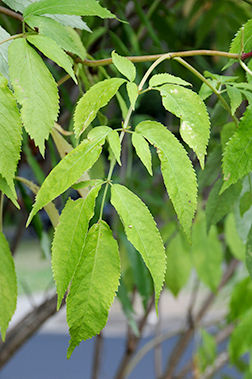Wild Edibles of Ohio
- Nicholas SirLouis

- Jun 28, 2020
- 2 min read
Updated: Mar 11, 2021
Ohio is home to many wild edible plants, including fruits, tubers, and berries. This is just a small list, detailing a few important and interesting plants. Always take extreme care when foraging for your own food, it can save your life!
All photos are from Virginia Tech Dendrology unless stated otherwise.
Pawpaw (Asimina Triloba)
Also known as the “Indiana Banana,” the pawpaw is Ohio’s only native fruit. Their taste can be described as a creamy mango-pineapple or a tropical apple.
Growing Conditions: floodplains, low areas with fertile, well-drained soil; grow in clonal colonies or patches
Appearance: large simple leaves, fruits are ovate and green-brown color
Season: matured by September - October



Black Raspberry (Rubus occidentalis)
A sweet and tart small berry high in anthocyanins, making it a useful dye as well.
Growing Conditions: often disturbed areas, like open woods, meadows, and along streams and trails
Appearance: sprawling brambles with thorned, arched stems; tightly clustered compound flesh ripening from green to purple black
Season: late June to early July



American Elderberry (Sambucus nigra L. ssp. Canadensis)
A smaller berry with a tart taste that can be bitter, and is often cooked before being eaten. They are often used to make pies and syrups.
Growing Conditions:
Appearance: shrub; umbrella-shaped clusters of cream-colored flowers, toothed leaflets; black to purple berries
Season: July-August



Grapes (Vitis spp.)
American grapes come in many varieties, and range widely from sweet to tart. They can be eaten raw, cooked in pies, and some are used for wine-making.
Growing Conditions: woodlands and forest edge habitats
Appearance: shaggy vine with tendrils, alternate lobed and toothed leaves, clusters of blue-purple-black berries
Season: late summer into fall



American Persimmon (Diospyros virginiana)
A beautiful tree with wood often used for golf clubs and pool cues, the american persimmon has a luscious orange fruit that has a rich, complex flavor with hints of caramel sweetness. Though often eaten raw, this fruit can be used in many different ways.
Growing Conditions: well-drained soil, rich bottom lands
Appearance: small tree with slender trunk, alternate whole ovate leaves, fruit is orange-yellow, round/oval, about .75-2.5 inches in diameter
Season: ripen mid-September onward



Jerusalem Artichoke (Helianthus tuberosus)
A plant that has been cultivated for generations, the Jerusalem artichoke, or sunchoke, has a tuber similar to a potato but with a slightly nuttier flavor. The tubers can be cooked like any other, and are often sliced and put on salads.
Growing Conditions: drained fertile soil with plenty of organic matter and sun
Appearance: Leaves up to 3 inches wide and 8 inches long, stems can grow up to 12 feet tall, yellow flowers in August and September
Season: tuber best harvested after several frosts



Photos taken from Illinois Wildflowers Index.
IMPORTANT: ALWAYS BE SURE OF EXACTLY WHICH PLANT YOU ARE FORAGING FOR BEFORE CONSUMING OR USING. PROPER CARE WITH IDENTIFICATION IS CRUCIAL.





Comments